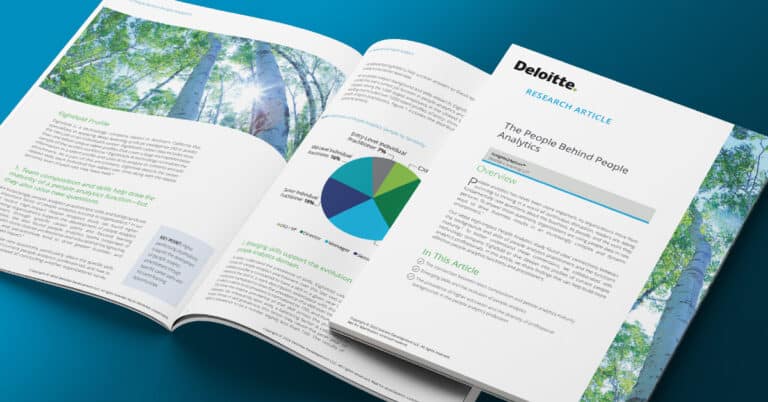
The people behind people analytics
The people behind people analytics
People analytics has never been more important. As organizations move from surviving to thriving in a world of continuous disruption, leaders are asking fundamentally new questions about the business, its people, and the work they perform. To answer these questions, organizations are using people data in new ways to drive business results in an increasingly complex and dynamic environment.
Deloitte’s High-Impact People Analytics study found clear connections between the backgrounds and skills of people analytics practitioners and the function’s maturity. To better understand these connections, Deloitte collaborated with Eightfold to dive deeper into profiles of current people analytics professionals.
In this report, Deloitte shares:
- The connection between team composition and people analytics maturity
- Emerging skills and the evolution of people analytics
- The prevalence of higher education and the diversity of professional backgrounds in the people analytics profession
Eightfold Profile
Eightfold is a technology company based in Northern California that specializes in applying deep-learning artificial intelligence (AI) to predict the next job in an individual’s career. Eightfold’s career data includes more than one billion unique talent profiles that cover a large and representative sample of the world’s workforce.3 Eightfold’s AI technology normalizes the information in a talent profile and uses AI to analyze its contents and add enrichment. As a part of this enrichment, Eightfold detects the career- related skills each individual has added over time along with the relative seniority level of each role they have held.4
1. Team composition and skills help drive the maturity of a people analytics function—but they also raise new questions.
Not surprisingly, people analytics practitioners’ skills and backgrounds are an important factor of people analytics success in organizations.5 In our most recent High-Impact People Analytics study, we found higher- performing organizations support the development of people analytics practitioners through specific career paths and focused learning opportunities. We also found people analytics teams comprised of individuals with more diverse professional and educational backgrounds, experiences, and perspectives tend to drive greater business- and workforce-related impact.6
These findings raise new questions, particularly about the specific skills and backgrounds of current people analytics professionals and how to enhance them. But instead of conducting another organizational survey,
we approached Eightfold to help uncover answers to these questions by looking at practitioner-level data.
For our people analytics background and skills research, Eightfold located profiles that had a current job function in people analytics and a current employer among the 1,000 largest employers in the United States. The resulting pool included over 7,000 talent profiles of entry- through C-level people analytics practitioners. Figure 1 includes the distribution of this sample by seniority.
2. Emerging skills support the evolution of the people analytics domain.
To better understand the prevalence of skills, Eightfold calculated skill trends for people analytics practitioners over the last two decades. An individual profile is considered to have a skill in a given year if the profile mentions the skill in a work description associated with that year. Skill trends are normalized to show the prevalence of a skill over time. The year in which a skill is most prevalent is normalized to 100, and numbers below 100 show the relative prevalence of that skill across the public profile database. For infrequently seen skills, a balancing factor is calculated to locate trends in skill prevalence; this factor may cause the peak year of highest prevalence to be a number slightly less than 100.
Copyright © 2022 Deloitte Development LLC. All rights reserved. Not for distribution. Licensed material.
You might also like...
Get the latest talent news in your inbox every month
By submitting this form, I consent to Eightfold processing my personal data in accordance with its Privacy Notice and agree to receive marketing emails from Eightfold about its products and events. I acknowledge that I can unsubscribe or update my preferences at any time.
